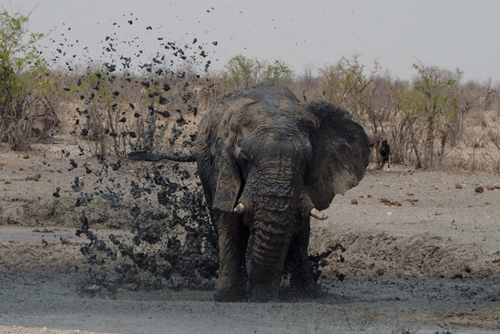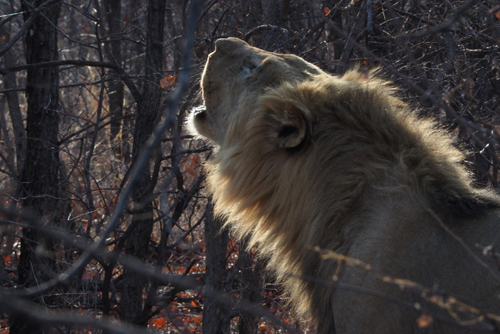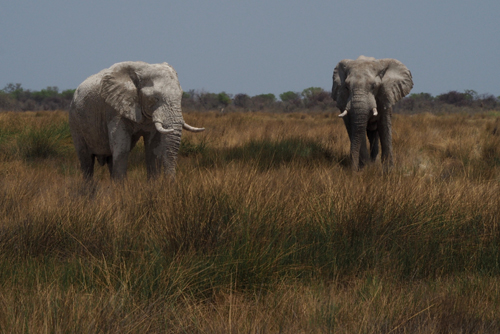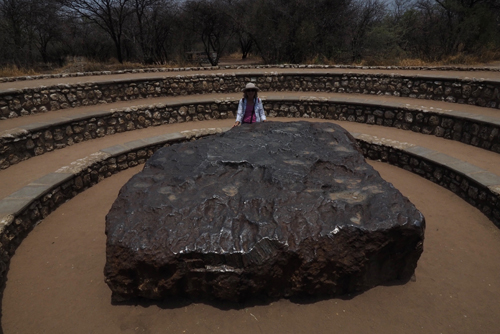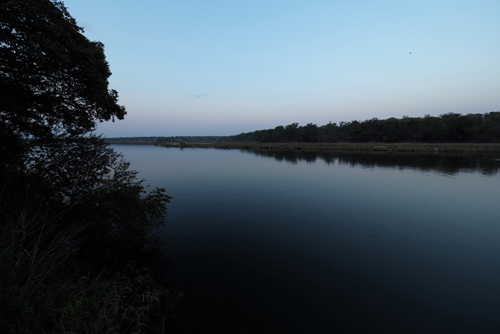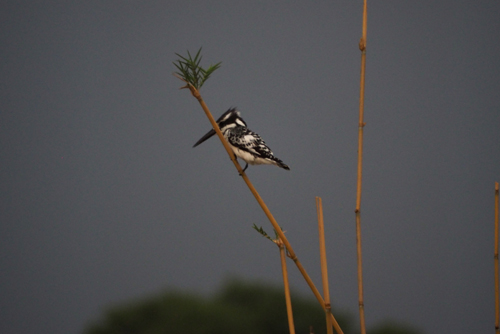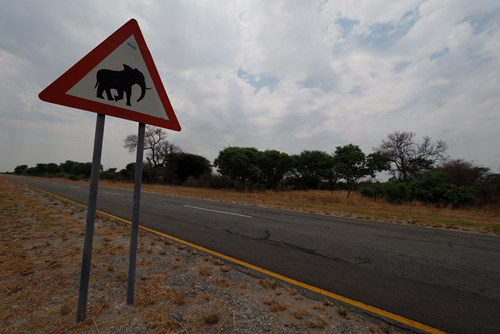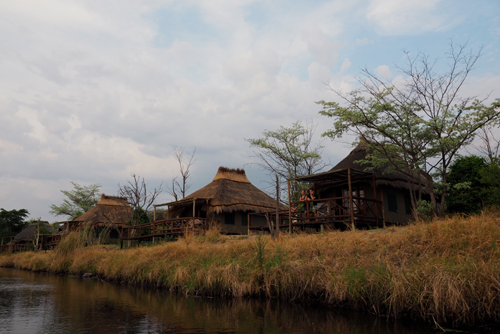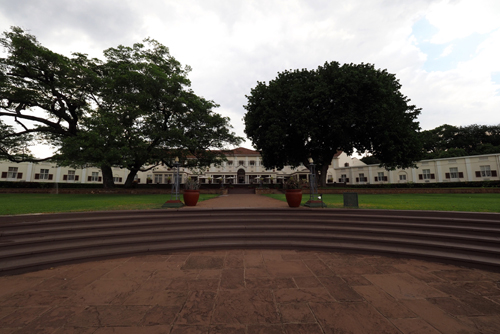Day 19, October 29: Damaraland to Ongava Game Reserve via Etosha National Park.
We left Toko Lodge mid morning and headed to Ongava Game Reserve.
It was suggested that we not take the sealed road route, but rather go via the Galton Gate, in the west and travel through the Etosha National Park to Andersson’s Gate.
This was our opportunity to ‘self drive’ our own game drive.
It was a great experience.
We stopped at five of the eight waterholes and found each one to have its primary inhabitants. They happened to be the birds or animals who were there when we visited.
This could change very quickly, as a new species came in to take control.
The ‘Elephant’ waterhole or Dolomietpunt was the fist we came across and as the name suggests it was full of elephants cooling off. There were zebras and springbok but they couldn’t get close to the water.
The ‘Vulture’ waterhole or Duineveld had ostriches but was dominated by the vultures. There were also zebras and a lone giraffe waiting patiently in the background.
The ‘Ostrich’ waterhole or Nomab also had vultures – fittingly the surroundings were flat and stark.
Our fourth stop was at the ‘Oryx’ waterhole or Olifantrus. The oryx soon left when two bull elephants arrived and started flinging muddy water around. There were also ostriches, eagles, vultures and zebras, keeping their distance.
Our final destination was the ‘Springbok’ waterhole, or Ozonjuitji m’Bari, there were also elephants, ostrich and zebras.
Day 20, October 30: Ongava Game Reserve.
Andersson’s Camp is inside Ongava Private Game Reserve and very close to Andersson’s Gate into Etosha National Park.
Ongava was created in 1991 when four non productive farms were combined. It’s 30,000 hectares and shares a common boundary with Etosha National Park.
We had arranged to do an afternoon game drive in Ongava so we spent most of the very hot day overlooking the waterhole that’s just metres from the hotel lounge.
There had been a few animals there the evening before but there was now a cavalcade of zebras, Black Faced Impalas, oryx, wildebeest and a giraffe.
The giraffe was so cautious approaching the waterhole, that it took over 1.5 hours from when it first arrived, until it spread its long spindly legs to take its first tentative sip.
It was good to have the animals come to us for a change.
Andersson’s Camp was named after Swedish explorer Charles Andersson (1827-1867) who was one of the first Europeans to expose Etosha to the outside world.
Andersson’s spirit for adventure was forged at a very early age, being the illegitimate son of an English bear hunter, Llewellyn Lloyd. (How many letter ‘l’s’ can a name have?)
All the lodges we have stayed in have been unique in their design, Andersson’s Camp was both strange and special.
The walls around the bathroom and toilet area were built from loose rock held together with a web of chicken wire. Inside there was also an additional covering of fly wire – just to stop the nasties from entering.
There was also a wide use of corrugated iron and raw timber.
The shower base was a large tin tub set into the floor and the towel rails were rough cut tree branches.
Yet there was the convenience of hot water, plenty of power outlets and an oscillating fan. There was even a small in-ground swimming pool.
Strangely there were no locks on any doors.
Day 21, October 31: Etosha National Park.
We were now back inside Etosha National Park and took the road from Andersson’s Gate, in the west, to the von Lindequist Gate, in the east.
The park was proclaimed a game reserve in 1907 and became a National Park in 1967. Etosha National Park is 22,270 square kilometres in size and gets its name from the Etosha Pan, which is 4,760 square kilometres in area. Etosha means ‘Great White Place’.
We made twelve stops, detouring off the main road, over a seven hour period. Eight of them were at waterholes.
The weirdest stop was at the Etosha Lookout. This was a two kilometre diversion, onto the Etosha Salt Pan itself. The pan is so large that you get the feeling you can see the curvature of the earth. Then there’s the added sensation of seeing water on the horizon, this is only a mirage.
The waterholes were again the best places to view the animals – there was a huge variety. From the more common, like zebras and wildebeests to the exotic, like rhinoceros and even lions.
We also saw ‘White Elephants’. These were actually bush elephants that had been wallowing in the light grey mud of the Springbokfontein Waterhole and had dried off to a very light grey.
The waterholes have wonderful names like Gemsbokvlakte, Olifantsbad, Ondongab and Charitsaub.
I think you need to speak Afrikaans to pronounce them.
Our accommodation was just outside the park at Emanya@Etosha Game Lodge. This, by contrast to the earthiness of Andersson’s Camp, was an Apple Store – a vision of minimalism in white.
But form certainly didn’t follow function at Emanya@Etosha, as everything from the building design to the shower seemed to be at odds with practicality. The bathroom was larger than most bedrooms, yet I even had trouble fitting into the tiny shower cubicle, which was stuck in a corner.
But that didn’t really matter, as there was no hot water anyway.
The the strangest paradox was the offer of a foot spa and massage after you returned from your game drive in Etosha National Park.
You are forbidden from leaving your car in Etosha, so this treatment is totally unnecessary.
I am not usually this critical of hotels – they are what they are.
However Emanya@Etosha Game Lodge claims to be five star. Their brochure proudly boasts: “Explore the warm soul of the African bush from the supreme comfort of your sumptuous accommodation…”
Despite the starkness of the design, we were continually reminded that we were still in Africa. There were ostrich, kudus and even a group of Leopard Tortoises wandering around the grounds. Then there was a very active waterhole close to the hotel pool.
There is always a bright spot in any stay and apart from the animals around the waterhole, they served ice cold draught beer.
Day 22, November 1: Etosha to Otavi Mountain Region.
This was our ‘est’ experience in Namibia.
Hoba Meteorite, the larg’est’ known in the world, was discovered by Jacobus Hermanus Brits in 1920.
It weighs approximately 50 ton, is 3 metres long and 1 metre thick. It struck the earth 80,000 years ago.
Having done over 3,500 kilometres on gravel roads it was strange to be back on bitumen.
Tar can be so boring.
Our only two, one night stops were at Emanya@Etosha Game Lodge and Roy’s Rest Camp in the Otavi Mountain Region.
They couldn’t have contrasted more.
Emanya@Etosha strove to be upmarket with a sleekness that verged on sterility. Also everything was impractical in its design.
While Roy’s, like Andersson’s Lodge, was eclectic, rustic and to my mind, far more reflected Africa.
The only thing that seemed to be at odds with the environment was the ‘House’ music playing in the bar.
That didn’t last long.
We arrived at Roy’s mid afternoon and the temperature was in the high thirties.
There was nothing to do but sit by the pool and jump in every now and then to cool off.
Wrecked cars seem to be a feature of the landscape in Namibia.
You see them by the side of the road, decorating the entrances to lodges or farms.
At Roy’s Rest Camp they were part of the architecture and built into the very fabric of the building.
Day 23, November 2: Otavi Mountain Region to Okavango Delta.
We were now in the north east of Namibia.
It was no longer dry and hot, but humid and hot.
Our accommodation in the Okavango Delta was at the Ngepi Camp on the Kavango River.
Our room was literally suspended over the water.
There were Hippos in the river, just opposite our treehouse, and elephants, buffalo and warthogs on the far bank.
On our first afternoon in Ngepi Camp a herd of more than 25 elephants came down to drink.
We never saw them again.
The shower and toilet were outside and to get to them, we had to negotiate an open deck.
There was no guard rail, just a three metre plunge into the river if you got it wrong.
We made a pact with each other, that if one of us needed to go to the loo during the night, they would wake the other and let them know.
Apparently there are also Crocodiles in the river, so a midnight swim wasn’t advisable.
Day 24, November 3: Okavango Delta.
It was a strange night at Ngepi Camp.
Apart from sleeping above the river, there was the added interest of strong winds and the constant threat of rain.
November is the start of the wet season and there are ever-building thunderheads in the sky. As the sun set in the west, the sky lit up in the east.
Then the thunder started.
All night it seemed to circle us but it never rained.
At some point during the night the thunder stopped, then at dawn the birds started.
It was a weird feeling being able to shower in the morning, while watching the Hippos wallow in the river just opposite.
I wondered how many other pairs of eyes were also looking at me.
Just over the river is the Bwabwata National Park, so it’s not surprising that there’s a lot of animal activity. It’s also an important migration route from Botswana to Angola for the African elephant. I guess the herd of elephants, that we saw the previous day, were on there way to somewhere else.
Ngepi Camp has a sense of humour.
It starts by telling you, as you are wending your way along the long approach, that; ‘You are nearly there.’
There are a variety of other signs, around the camp, that show a real sense of fun.
There’s a toilet block just near the hotel bar. Not unusually it had two entrances, male and female, however once inside it was actually one facility, with two toilets.
The one on the left was in grey with the toilet seat permanently bolted up. While the one on the right was decorated in pink.
My favourite sign was the one in front of the pontoon swimming pool, that’s actually in the river. ‘World’s 1st Hippo and Croc Cage Dive’
Day 25, November 4: Okavango Delta to Caprivi Strip.
We took the B8 or Trans Caprivi Highway across the Caprivi Strip to Camp Kwando.
This was through the Bwabwata National Park which was full of signs warning us of Elephants.
We didn’t see one.
Camp Kwando was on the Kwando River, which is the border between Namibia and Botswana.
Our view was of another country and our next destination.
The Caprivi Strip or ‘panhandle’ is the finger of land in north east Namibia that borders Botswana, Angola and Zimbabwe. It’s the only place on earth where four countries intersect.
Variations on the colour khaki are everywhere and on everything in Southern Africa. Tents, furniture, guides uniforms, vehicles and especially tourists. They are all decked out in it.
The French and Germans tour groups love to get into the African experience with a uniform of khaki hats, shorts, T-shirts, shirts, boots and sox.
There’s more khaki than you’d see in Puckapunyal during a graduation day ceremony.
I somehow can’t see them wearing it in Paris or Berlin once they return home.
The layout of Camp Kwando was very simple and it worked.
There were three circular areas, under thatched roofs, that were linked by a boardwalk.
In the centre was reception and a lounge. To the right was the dining area and to the left, the bar.
All this faced the Kwando River.
Large seed pods were continually falling around the lodge area, dislodged either by wind or the Grey Lourie Parrots or ‘Go Away Bird’ that were everywhere.
Day 26, November 5: Kwando River on the Caprivi Strip.
We had booked a boat trip on the Kwando River in the afternoon, so the morning was spent sitting on our veranda, watching the river flow past and the seed pods dropping.
This was our last full day in Namibia so it was great to be able to reflect on what we had seen and done.
We had been hoping to take a dugout canoe or mokoro through the backwaters. Unfortunately this wasn’t possible as the drought had reduced the water level so much they weren’t passable.
The bird life around Camp Kwando was relatively active but animals sightings were sparse.
I saw a lone buffalo on the Botswana side but not much after that, until we did the river cruise.
The buffalo was an old bull that had passed his used by date and was now destined to wander the rest of his days alone.
Life in the wild it tough. There’d be no retirement, surrounded by family and friends for him.
Kwando is a river that flows both ways. Like the Tonlé Sap in Cambodia, it’s flow changes direction from the wet to the dry season.
Elephants are destructive, but they need to be.
Much of the deforestation that we had seen is all part of the ecosystem in Southern and Eastern Africa that can be attributed to elephants. They tear down the trees for food, which then allows grass to grow, providing food for grazing mammals.
Our guide for the afternoon river cruise was Hidden (not a typo but his real name). He lived in a local village and told us that many of the backwaters were now too shallow to use, even for the locals.
We bottomed out a number of times, even on the main river. At one point I wondered if it was the river bed we bumped over or a submerged hippo.
There was large amounts of floating reeds in the river, again caused by elephants. And again beneficial, as it helps the plants to proliferate by dispersing them downstream.
Our second night at Camp Kwando was jut as hot and humid as the first.
It was uncomfortably warm in the dining area even though it was outside. The problem was that there was no ventilation in the thatched roof.
There was nowhere for the hot air to go.
Using convection, the Egyptians discovered natural air conditioning, with ‘Windcatchers’, around 1,300 BC. I was beginning to wish that the concept had travelled south.
Day 27, November 6: Kwando River on the Caprivi Strip to Chobe River, Botswana.
We took the longer, more scenic, route to Katima Mulilo along the C49. The road had recently been sealed, so the drive was easy.
The border crossing between Namibia and Botswana was painless. The main concern was bringing a foreign registered vehicle into the country.
Fortunately our paperwork was all in order.
We saw so many road signs, warning us of elephants, in Namibia but never sited one. It was therefore ironic that as soon as we crossed the border into Botswana, we saw elephants by the roadside.
But there were no signs anywhere.
Our accommodation was in the Water Lilly Lodge, an older style hotel in the centre of Kasane and right on the Chobe River.
Kasane has a Spar supermarket and therefore ranks as very sophisticated, according to the office staff at our last stop, Camp Kwando.
Our room looked right onto the pool which was very inviting in the 35°C heat. There was also a 35 meter high pole next to the hotel buildings and I wondered what it was.
Then it struck me, it was a lightning conductor.
A useful feature, considering the thunderstorms we had had over the last few days. And essential, knowing the hotel roof was thatched.
Day 28, November 7: Chobe River, Botswana.
Through the hotel we booked a morning game drive in the Chobe National Park. It started at 5:30am as this is the best time to see the animals.
The most interesting part of this drive was that we spent a lot of time on the Chobe River, the border between Botswana and Namibia.
The river backdrop made the photos different to what we had experienced.
Chobe National Park is 11,700 square kilometres in area, which gives the animals plenty of places to hide and avoid the nosy tourists.
We did see lions, elephants, hippos and a rare Sable Antelope.
There were also hundreds of impalas. These are known in Chobe as ‘McDonalds’, as they are fast food for lions.
Young Impalas are born at the same time each year, at the start of the rainy season. They have the amazing ability to be able to control the gestation period and choose when to give birth.
As well as the morning game drive we had also booked an afternoon game cruise.
Our boat contained a mixture of nationalities. Two Spanish girls, a Dutch couple, three from Japan and the two of us.
Of course English was the language of conversation.
The Chobe and the Kwando are in fact the same river, with the direction of the flow influenced by the seasons.
Like the morning drive, the afternoon boat trip offered a very different perspective for game park photography.
Again the river aspect was the focus.
The Chobe River and Chobe National Park are a very important tourist attraction in Botswana.
This means lots of tourists. It was crowded in the park in the morning and just as busy on the river in the afternoon.
Looking over the Chobe River into Namibia we could see plumes of smoke rising into the sky. This was coming from the crop burning, that happens just prior the wet season.
I have always wondered why a shot of a hippo yawning was so special. That afternoon, on the Chobe River, I discovered that the ’yawn’ is actually a bull trying to assert his dominance over the herd.
We started the day with a sunrise and ended it with a sunset.
In Africa both are spectacular.
Day 29, November 8: Chobe River, Botswana to Victoria Falls, Zimbabwe.
Our Toyota was ‘repossessed’ by a driver from Autovermietung Savannah CC, who would be taking it back to Windhoek.
He would only take a day to get back.
We then were driven to the Zimbabwe border. Unfortunately a group of French tourists got there just before us.
This border crossing was in stark contrast to the one coming into Botswana.
There twenty people to be processed by two officers who seemed to do everything manually and in triplicate.
Then that paperwork was passed on to another guy who actually put the visas in the passports.
As we intended to walk across Victoria Bridge to Zambia at Victoria Falls we bought ‘double entry’ visas.
This made things even more complicated.
The drive to Victoria Falls was through the Zambezi National Park. There wasn’t much activity, just a few Elephants crossing the road.
It was very hot when we arrived in Victoria Falls, about 36°C. We were staying at Amadeus Gardens, a guest house that was a little too far out of town. Stupidly we walked into Victoria Falls township in the heat, there we found the Shearwater Cafe.
They had an espresso machine and a contemporary menu, which included the obligatory serving of ‘wildlife’.
The Shearwater Group seem to own most of Victoria Falls. Their name wasn’t only on the cafe but on just about every other tourist activity in the area.
At the recommendation of our hotel, we went to the Victoria Falls Safari Lodge for dinner. Even though it was very close to our hotel, it was suggested that we take a taxi there, as most of the backroads in Victoria Falls are closed after dark.
Apparently ‘wild animals’ still wander the streets at night. I wondered what wild animals they were referring to.
The Victoria Falls Safari Lodge is built on a plateau, overlooking Zambezi National Park. Here you can watch the animals coming down to the waterhole, while you are also having your evening drink.
Day 30, November 9: Victoria Falls, Zimbabwe.
Due to hyperinflation in the 1990s, the Zimbabwe government stopped printing their own currency in 2009. They now only use US Dollars.
This has its issues.
One is that the smallest denomination is one dollar – you never get change smaller than that and every bill seems to come to an even dollar.
The next day we walked back into the Victoria Falls township and found a much shorter route. This was good as the temperature was skyrocketing into the high thirties again.
Visiting Victoria Falls was the main objective of our time there, that and having High Tea at the Victoria Falls Hotel.
We had a long walk along the falls, unfortunately many of the attractions were lacking water, due to drought – we were still the dry season
November in Zimbabwe sees the lowest water level and the hottest temperatures.
There are 16 viewing points along the length of the falls and we stopped at them all but didn’t necessarily take snaps.
Victoria Falls or Mosi-oa-Tunya (the indigenous Tonga name meaning ‘The Smoke that Thunders’) is on the Zambezi River and borders Zambia and Zimbabwe.
In 1855 David Livingstone was believed to have been the first European to discover the falls while on his quest to find the source of the Nile River. He named his discovery in honour of Queen Victoria of Great Britain. There is a statue honouring Livingstone’s achievements at the start off the Falls Walk.
Victoria Falls, along with Niagara Falls in the US and Argentina and Brazil’s Iguazu Falls are regarded as the world’s premier waterfalls.
Victoria Falls was designated a UNESCO World Heritage Site in 1989.
The Victoria Falls Bridge is at the end of the 16th viewing point. It crosses over the Zambezi River and is the border post between Zimbabwe and Zambia.
The bridge is designed as a Parabolic arch and completed in 1905, with a total length of 198 meters and a hight of 128 meters.
It was conceived by Cecil Rhodes, who founded the southern African territory of Rhodesia. His dream was to: “…build a bridge across the Zambezi where the trains, as they pass, will catch the spray of the Falls.”
Unfortunately there was no spray that day.
Later that afternoon we walked to the Victoria Falls Hotel for High-Tea on Stanley’s Terrace.
This overlooks the Second Gorge and the Victoria Falls Bridge.
We decided not to have either tea or coffee with our tiered platter of sandwiches, cakes, and Devonshire Tea.
It was far too hot.
I did have a wine and Thea, keeping with British Colonial tradition, had a gin and tonic. After our High Tea we sat on the lawn and watched the warthogs playing on the grass, while security chased away the pesky baboons.
The Victoria Falls Hotel was built by the British in 1904 and was originally designed to house workers from the Cape-to-Cairo railroad. The property is still owned by the National Railways of Zimbabwe but is now a luxury five star hotel.
When we returned to our hotel, which certainly wasn’t five star, there were a group of Americans having a drink around the pool.
I think they were drowning their sorrows, as Donald Trump had just been elected.
We all agreed that we would remember where we were that day. Just as we had when the news broke about the assassination of JFK, Chernobyl and 9/11.
It was another world disaster.
Day 31, November 10 – Victoria Falls, Zimbabwe to Port Elizabeth, South Africa.
Our flights from Victoria Falls to Port Elizabeth, via Johannesburg, was in Business Class.
This wasn’t our choice.
It was the only flight we could get and it cost us more than our Emirates flight from Cape Town back to Melbourne.
Determined to make the most of the expense we went in search of the Business Class lounge, as soon as we checked in at Victoria Falls International.
It was closed.
The lounge in Johannesburg was open and very full.
I allowed myself one beer, as I had to drive, once we got into Port Elizabeth and picked up the rental car.
So much for flying Business Class.
We arrived in Port Elizabeth and the temperature had plummeted 20°C to 16°C, it was also raining.
After getting the hire car we went straight to the Admiral’s Lodge Guest House.
As they didn’t serve dinner we had to quickly find somewhere to eat.
The closest place was a drive away which was a pity because Charlie’s served excellent Craft Beer.
Yet again that day I was restricted to one glass.
